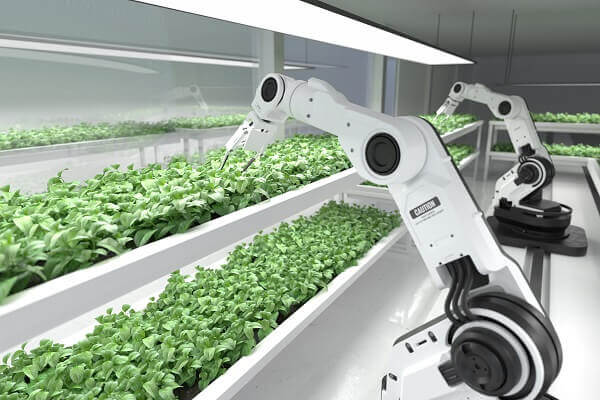Indoor vertical agriculture offers a comprehensive solution to several problems commonly encountered within conventional farming.
The most pressing issues currently facing traditional agriculture include climate change, an ever-increasing population, and global food shortages.
Utilizing cutting-edge hydroponic and aeroponic farm management systems, indoor vertical agriculturalists can grow their food products within controlled environments. This results in the time-effective cultivation of sustainable, nutritious, and fresh produce.
Indoor farmers can replicate natural outdoor growing conditions if they have the right technological frameworks in place. The fruits, vegetables, herbs, and mushrooms that are farmed in this manner all grow in vertical beds rather than horizontal rows.
They grow without soil or sunlight, which means that several key tech integrations are required to facilitate their development.
Automated technologies alleviate several pain points in the vertical crop growth process. These problems commonly include planting accuracy, seedling transportation, light intensity, bespoke fertilization, and food security.
This guide delves deep into the burgeoning integration of automation within the indoor vertical farming industry. For in-depth information on the technology that enables automated agriculture, read on.
The Role of Automation in Indoor Vertical Farms
Automation is used in several critical areas within indoor vertical farming, one being irrigation.
Automated technologies regulate the water that is distributed on indoor produce. This supplements a lack of rainwater and provides the farmed goods with several essential macronutrients.
Nitrate – a bioavailable form of nitrogen – is one nutrient that is augmented into the vertical farming irrigation process. This helps to produce and develop lush and healthy foliage, thereby improving the overall taste and freshness of the grown goods.
By facilitating a seamless irrigation process, automated systems also help to reduce the labor costs typically attached to vertical farming.
Automated crop production reduces the need for an extensive workforce and, more importantly, decreases the likelihood of costly human errors being made.
When integrated into the conveyor system, automated machine learning artificial intelligence can pinpoint farming inefficiencies in real-time. It can unearth drone malfunctions before they bring the food supply chain to a halt.
It can also alleviate external conditions that could potentially hamper the climate-controlled environment.

Agricultural Tasks Performed by Indoor Automated Systems
Modern indoor vertical farms rely heavily on the integration of cutting-edge automation technology. The specific agricultural tasks performed by indoor automated systems are as follows:
Seed Planting and Seedling Transportation
All indoor vertical farming operations begin with planting seeds in starter growing mediums. This process is automated by innovative dispensing technology, a top tech tool that places individual seeds accurately within the seedbed.
Once the seeds have developed proficiently, the mediums are transported down automated conveyor systems. This continuously transfers the seedlings to different environments within the vertical that better match their current growth requirements.

Utilizing advanced mobile robotics, and automated technologies then physically lift, carry, orient, and deposit the seedlings to larger farming beds. This pick-and-place process requires a delicate touch; one wrong move and the young plant could be snapped in two.
Soft robots, silicone machines, and air pressure-controlled robotic arms are at hand to ensure full-scale finesse at this intricate transportation stage.
These tools are capable of manipulating their actions to adhere to differing applications. They carefully grasp the seedlings to prevent breakages, bruising, and ultimately wastage.
As more food manufacturers join Taylor Farms in adopting this technology, it’s only projected to become more prevalent within the indoor vertical agriculture industry.
Lighting, Temperature Setting, Watering, and Fertilization
Controlled environment agriculture isn’t dictated by the changing of the outdoor seasons. Optimized indoor growing conditions are facilitated at all points in the year by automated lighting, temperature setting, watering, and fertilization processes.
Using timed dispensing technology, vertical farmers can create a continuous growth cycle that requires little human interaction.
Whether their produce needs a specific spectrum of light or a particular amount of fertilizer, they can always rely on their automation tech to dispense exact crop growth requirements.
This enables a cost-time and labor-effective food production operation wherein routine cultivation tasks are performed without disruption.
Indoor agriculturists can use cutting-edge farm reporting software to gain more control over their controlled environments. This software solution provides farmers with a centralized platform to monitor, audit, and improve crop growth cycles.
Farm reporting software can also provide up-to-date inventory support when integrated with data warehousing. This allows farmers to consistently remain on top of their food supply and crop production rates.

How Automated Systems Improve Crop Production
Automated agriculture systems manage crop production with unrivaled precision and efficiency. They are capable of growing crops without the need for comprehensive human support.
Crucially, this allows modern farmers to focus more time and effort on selling their produce to their consumers.
Speed is one of the most significant benefits of adopting automated farming systems. Traditional farms have long been blighted by slow processes that are made even slower by human miscommunication.
Indoor vertical agriculturalists utilize computerized frameworks that work in conjunction with one another. From planting to picking, every stage of the crop production process is connected via a centralized collaboration unit.
This ensures that each individual crop receives the exact level of care it needs, exactly when it needs it in the growth cycle.
Accelerating the crop production process using automation is crucial for the future of the entire agriculture industry.
By 2050, the global population will exceed 9.7 billion, and food production rates will need to rise by at least 70% to handle the increased nutritional demand posed by this expansion.
With time-effective automated systems at their disposal, modern farmers will be able to churn out new, fresh produce daily.
Automated systems will be at the forefront of the indoor vertical farming industry for years to come. If you want to profit from this tech trend, now’s the time for you to be developing AI-based robotics software.

